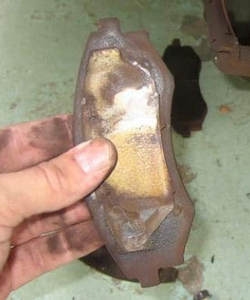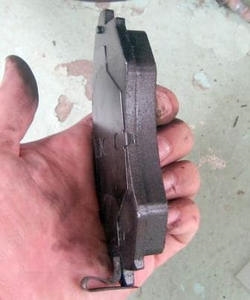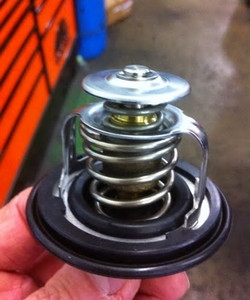Service Tips
Brakes?
So it's time to replace your brakes!
This Service Tip episode was prompted by a family member who has already listened to the squealing of her brakes too long and ended with a much larger repair bill because she did not have the brake pads replaced in time. How did this happen?
In a four wheel disc pattern, each wheel has two brake pads that sit in a caliper, on opposite sides of a rotor. When you press on the brake pedal, the caliper clamps the brake pads against the rotor causing friction and therefore slowing the vehicle. These are wearable parts and do not last forever. Their life span depends greatly on the type of driver you are. Spirited? You'll replace sooner. Careful and casual? You will get a longer life.
Generally speaking, when your vehicle is in for service at Honda of Oakland, we always do a visual inspection of your brakes. It's a safety factor and we know you bring your vehicle to us because you trust us with the safety of your vehicle. But what if you haven't been to Honda of Oakland on a regular basis, maybe you've chosen to have the oil changed at an aftermarket facility that may not be as focused on your safety. Maybe you've now been hearing this squealing noise for some time and today you pressed on the brake pedal and there was a gut wrenching grinding noise.
Let's dissect a bit. Generally you normally will get somewhere around 30,000 miles from a set of brake pads. Again, this completely depends on your driving habits. Once the brake pad has worn to a minimum thickness, the squeaker will begin to hit the rotor every time you brake. If you ignore this, then you wear the pad down to the rivets that hold the pad to the backing of the brake pads. It is the metal rivets that then begin to dig into your rotor and cause the bigger damage. If you didn't damage the rotors too badly, it is possible to 'turn' or resurface the rotors and they may be used again, assuming they meet minimum thickness standards once 'turned'. If not you will need to incur the added expense of replacing the rotors.
So the rule of thumb here is, make sure to always take your vehicle to a responsible technician, one who is as concerned about your safety as you are. Secondly, if you hear noise or a squealing/squeaking noise when you press on the brake. Make an appointment to bring your vehicle in for an inspection.
This week Honda of Oakland will replace the front brake pads on all Honda for just $159.95, the resurfacing or replacement of the rotors will be an added charge./p>
How Often Should You Change Your Antifreeze/Coolant?
I was speaking with our Shop Foreman, Robert Isbell, the other day as he was working on a customer vehicle. I Inquired as to what was wrong with the vehicle. He stated that the thermostat stuck and as a result the vehicle overheated and had to be towed in. He further explained that the thermostat is a mechanism that opens and closes many times during the time the engine is running to maintain proper engine temperature. If it sticks closed it prevents the coolant from circulating through the engine, it overheats and suddenly your stranded, worse, you might do major engine damage. I asked why the thermostat would stick. He stated that when the engine coolant is not maintained properly, it becomes dirty and sticky and deposits form on the plunger of the thermostat and as a result, one day it sticks closed and doesn't open again. Result? Stranded. Don't know about you, but just the sound of the word 'stranded', is bothersome. So I thought this might be a good subject to begin our monthly 'Service Tips' with.
For "ordinary" antifreeze, Honda recommends coolant changes every two years or 30,000 miles. On newer Honda's ( 2006 and Up) the on-baord diagnostics will let you know via the "Maintenance Minder". Some say it's not a bad idea to change the coolant every year for maximum corrosion protection.
CAUTION: New long life coolants provide extended life only when used in a clean system mixed with water. If mixed with ordinary antifreeze and/or old coolant in a system, the corrosion protection is reduced to that of normal antifreeze (2 to 3 years and 30,000 miles).
Corrosion Inhibitors
The life of the antifreeze depends on it's ability to inhibit corrosion. Silicates, phosphates and/or borates are used as corrosion inhibitors to keep the solution alkaline. As long as the antifreeze remains so, corrosion is held in check and there's no need to change the coolant. But as the corrosion inhibiting chemicals are used up over time, electrolytic corrosion starts to eat away at the metal inside the engine and radiator. Aluminum is especially vulnerable to corrosion and can turn to Swiss cheese rather quickly when conditions are right. Solder bloom can also form in copper\brass radiators causing leaks and restrictions. So changing the coolant periodically as preventative maintenance is a good way to prevent costly repairs.
The basic idea is to change the coolant before the corrosion inhibitors reach dangerously low levels. Following Honda's change recommendations is usually good enough to keep corrosion in check, but it may not always be the case. That's why more frequent changes may be recommended to minimize the risk of corrosion in bimetal engines and aluminum radiators.
Checking The Antifreeze
One way to find out if it's time to change the antifreeze is to test it, and this can also be performed for you when you bring your vehicle in to Honda of Oakland for it's regular maintenance. Several suppliers make special antifreeze test strips that react to the pH (alkalinity) of the coolant and change color. If the test strip indicates a marginal or bad condition, the coolant should be changed.
Changing The Coolant
Reverse flushing is the best way to change the coolant because draining alone can leave as much as 30 to 50% of the old coolant in the engine block. Reverse flushing also helps dislodge deposits and scale which can interfere with good heat transfer.
The concentration of antifreeze in the coolant also needs to be checked prior to the onset of cold weather. A 50/50 mixture of antifreeze and water is recommended and will protect against freezing down to -34 degrees F and boil over protection to 263 degrees F.
For maximum protection, up to a 70% mixture of antifreeze can be used for freezing protection to -84 degrees F.
CAUTION: Do not use more than 70% antifreeze, and never run straight water in the cooling system because it offers no corrosion, freezing or boil over protection.


This image shows a very worn brake pad.

This image shows a new brake pad.
